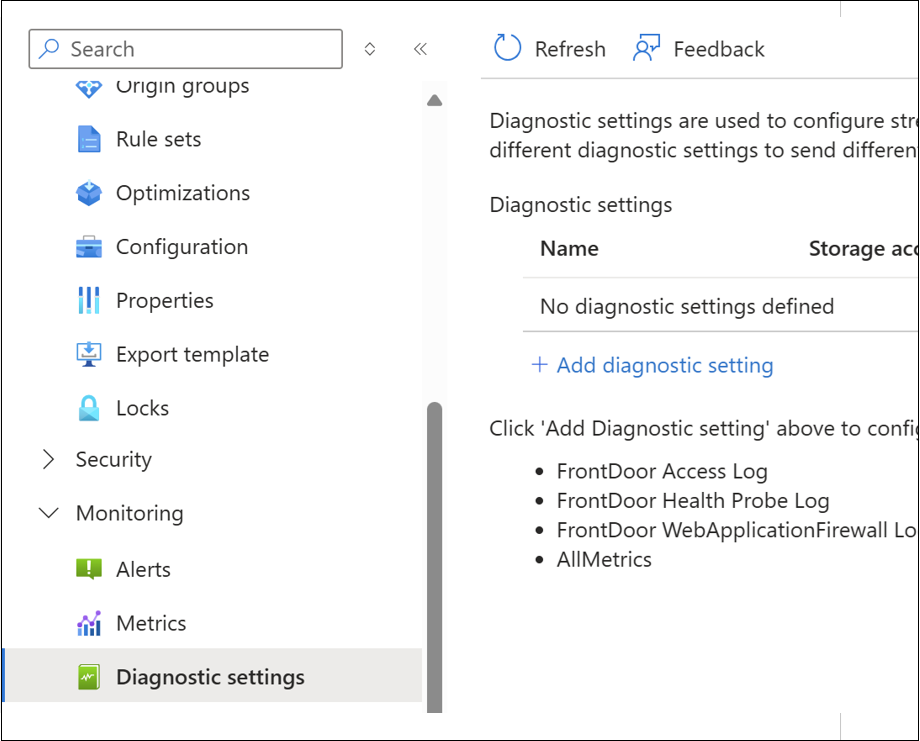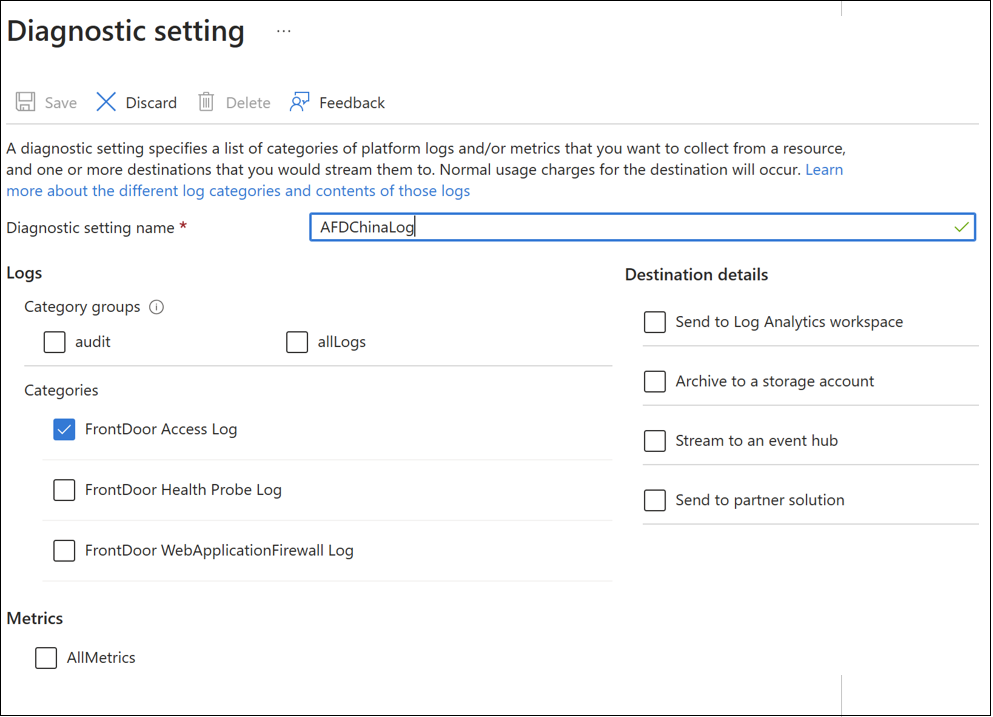Note
Access to this page requires authorization. You can try signing in or changing directories.
Access to this page requires authorization. You can try changing directories.
Azure China CDN will be retired and stop serving traffic from December 1, 2025. Please migrate to Azure Front Door or an alternative CDN before November 15, 2025. This document talks about the comparison and resource mapping between Azure China CDN and Azure Front Door and help you determine if Azure Front Door is the best option for migration. If your Azure China CDN profile is compatible with Azure Front Door, you can migrate by following steps in Azure China CDN migration to Azure Front Door guidance. You can also learn more about China CDN retirement FAQ.
Important
If you don’t migrate by November 15, 2025, Azure Front Door team will migrate eligible Azure China CDN profiles to Azure Front Door. However, if your Azure CDN profile is disabled or has no active request in the past 3 months, or your Azure CDN profile isn’t compatible for migration based on the gap mentioned in Azure China CDN and AFD comparison, Azure Front Door can’t and won’t migrate your profile and your service will experience service disruption from December 1, 2025. In this case, you need to consider an alternative third party CDN solution.
Comparison of Azure China CDN and Azure Front Door
Azure China CDN is a legacy content delivery service built on top of local CDN providers’ infrastructure in China, using API integrations. While it enabled content delivery within China, it lacked deep, native integration with the Azure platform and did not offer a unified experience with Microsoft’s global cloud services. Azure Front Door, on the other hand, is Microsoft’s next-generation, fully native CDN and application delivery platform. It provides seamless integration with the Azure ecosystem, consistent management experience across global and China regions, advanced security features like Web Application Firewall (WAF), and developer-friendly tools for automation and DevOps. Azure Front Door delivers consistent performance, security, and innovation for customers operating both in China and globally.
Here is a high-level comparison between Azure China CDN and Azure Front Door.
| Property | Azure China CDN | Azure Front Door |
|---|---|---|
| PoPs coverage | 600+ across mainland China | 2 PoPs in Azure China North 3 region and Azure China East 3 region. |
| Pricing model | CDN outbound data transfer, Content Delivery Network (CDN) Pricing Details or P95 billing model | Details in Azure Front Door pricing.
|
| Security features | IP whitelisting/blacklisting |
|
| CDN features |
|
Self-service for compression, TLS policy, flexible routing rules via rules engine, etc. More details in Azure Front Door |
| Dev-Ops | Only creation uses Azure API | Terraform, PowerShell, CLI, SDK, API |
Compatibility to migrate Azure China CDN to Azure Front Door
Not all Azure CDN profiles are eligible for migration to Azure Front Door. You can determine if your Azure CDN profile is eligible for migration to Azure Front Door by referring to this section or going to Azure portal where you will see the compatibility.
If you are using a feature that’s not supported Azure Front Door as indicated in the resource mapping between Azure China CDN and Azure Front Door section, you are not compatible for migration. Please consider a third party CDN provider before November 15, 2025. AFD team can’t migrate your CDN profile to AFD in this case. Inaction will incur service downtime starting from December 1, 2025.
If you are using features that are enabled but not supported on Azure portal or API as stated in Customizations by service team per requests, you have to migrate to AFD on your own before November 15, 2025, AFD can’t migrate on your behalf. If you are using a feature that’s not supported Azure Front Door in this section, your Azure CDN profile is not compatible with Azure Front Door, please consider a third party CDN provider before November 15, 2025. Inaction will incur service downtime starting from December 1, 2025.
If you are using the global acceleration or overseas acceleration, AFD team can’t migrate your CDN profile. Please follow steps in Azure China CDN migration to Azure Front Door guidance to migrate on your own or consider a third party CDN provider before November 15, 2025. Inaction will incur service downtime starting from December 1, 2025.
Resource mapping between Azure China CDN and Azure Front Door
Azure China CDN support self-service features and customizations by service team per requests.
Here are the resource mappings for self-service features- Chinese version
| Feature category | Azure China CDN | Azure Front Door |
|---|---|---|
| Billing Type | P95 Billing type | No |
| Billing Type | Data transfer per GB | Yes, and a few other meters. |
| Endpoint/CNAME | Exampledomain.mcchcdn.com | exampledomain-hash.z01.frontdoor.azure.cn |
| Acceleration Type | Web,Download,HTTP HTTP VOD | Yes |
| Image processing | Not supported on AFD. | |
| Overseas acceleration | Create AFD in public cloud | |
| Global acceleration | Create public AFD and China AFD, and create ATM to do traffic routing. AFD can’t migrate this scenario. | |
| Domain management | Property: Origin Host and Host header | Config in Origin group, supports multiple origins |
| Cache rules: Full path,Directory,File extension | In Rules Engine, configure rule condition to Request path or Request file extension. Here is an example of the rules engine for default caching behavior for Azure China CDN on AFD. Please make changes based on your own configuration. |
|
The cache templates and its config as no cache. |
No need to configure on AFD specifically. | |
| Ignore Query String | Enable caching in Route or Route configuration override's Query string caching behaviour. | |
| Cache rule: ignore cache control | Not supported on AFD. | |
| Cache rule: ignore cookie header Set-cookie | Not supported on AFD. | |
| HTTP header | Rules engine-> action-> modify response header-> append | |
| Access control: allow empty referer | Not supported on AFD. | |
| Access control: configure whitelist blockage | In WAF custom rules |
|
| Access control: configure blacklist blockage | In WAF custom rule |
|
| HTTPS Bring Your Own Certificate | Domain-> enable HTTPS-> Upload certificate to Azure Key Vault. | |
Acceleration region |
Refer to migration sections | |
| Content management | Purge | Purge cache in Overview  |
| Preload | Not supported on AFD. | |
| Self service | Logging | Diagnostic logs using Azure Monitor  |
| Reports | Not 100% match, only basic request/usage via Azure Metrics. |
|
| API key | Supported via standard Azure Rest API authentication. Certificates are uploaded to Azure Key Vault under AF Secrets. If you do not enable the auto rotation for BYOC certificate, AFD team can’t migrate on your behalf. Please enable auto migration. |
Customizations by service team per requests
| Azure China CDN | Azure Front Door |
|---|---|
| Enable/disable IPv4/IPv6 | By default dual stack, not configurable |
| Origin ports | In Origin |
| IP whitelist | In WAF custom rule |
| Rate limiting | WAF custom rule |
| Authentication | Not supported on AFD yet |
| URL rewrite | Rules engine-> URL rewrite |
| customize cache key | Not supported on AFD yet |
| request | Yes, enabled by default. |
| Customize TLS version | Domain-> TLS policy, details in Azure Front Door TLS policy |
| Gizp, Broli compression | By default. Compression is only supported when caching is enabled. |